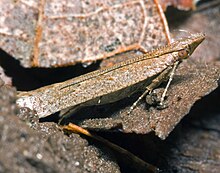Gelechiidae
| Gelechiidae | |
|---|---|
 |
|
| Dichomeris ligulella | |
| Scientific classification | |
| Kingdom: | Animalia |
| Phylum: | Arthropoda |
| Class: | Insecta |
| Order: | Lepidoptera |
| Superfamily: | Gelechioidea |
| Family: |
Gelechiidae Stainton, 1854 |
| Subfamilies | |
|
See text |
|
| Synonyms | |
|
Brachmiinae |
|
See text
Brachmiinae
Deoclonidae
Gelechiadae (lapsus)
Physoptilinae
(but see text)
The Gelechiidae are a family of moths commonly referred to as twirler moths or gelechiid moths. They are the namesake family of the huge and little-studied superfamily Gelechioidea, and the family's taxonomy has been subject to considerable dispute. These are generally very small moths with narrow, fringed wings. The larvae of most species feed internally on various parts of their host plants, sometimes causing galls. Douglas-fir (Pseudotsuga) is a host plant common to many species of the family, particularly of the genus Chionodes, which as a result is more diverse in North America than usual for Gelechioidea.
By the late 20th century, over 900 genera with altogether more than 4,500 species were placed here, with about 650 generea known from North America alone. While these figures are certainly outdated, due to the many revisions to superfamily Gelechioidea and new descriptions of twirler moths, they still serve to show the enormous biodiversity contained in this important family.
Being abundant, fecund plant-eaters, many species are agricultural pests, including:
The voracious habits of their larvae make twirler moths suitable for biological control of invasive plants. The spotted knapweed seedhead moth (Metzneria paucipunctella), for example, is used to control spotted knapweed (Centaurea maculosa) in North America.
...
Wikipedia
